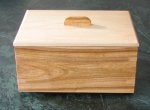I came to the wood species forum in search of an answer from the experts as to the worthiness of apple tree wood in wood working projects. Is it a "soft" or "hard" wood? What is its workability on lathe, router, drill, saw etc? What is the best application for apple wood? I ask these questions because I will need to take down an expired apple tree in my backyard this year. The trunk diameter is about 8", and some branches are 4", so the wood yield could be promising for some project, after suitable drying time. Any tips are sought.
Rick
Rick






